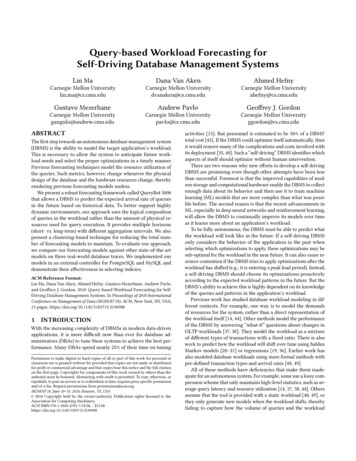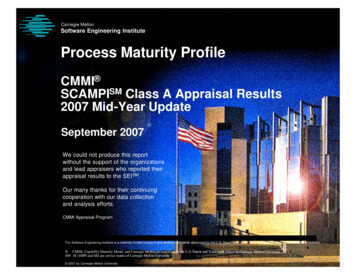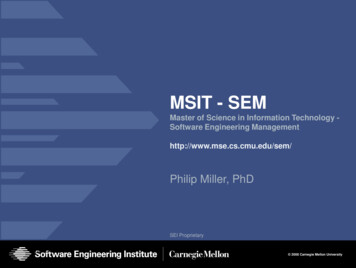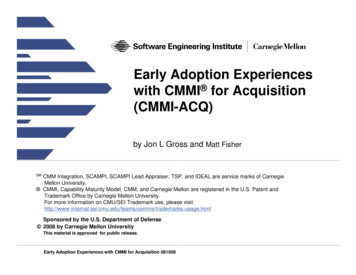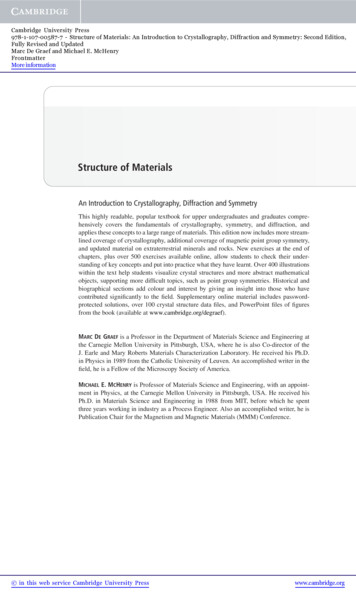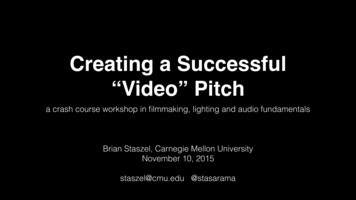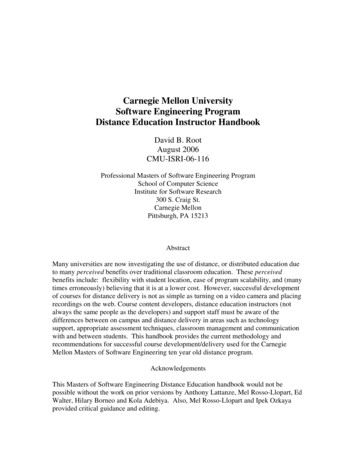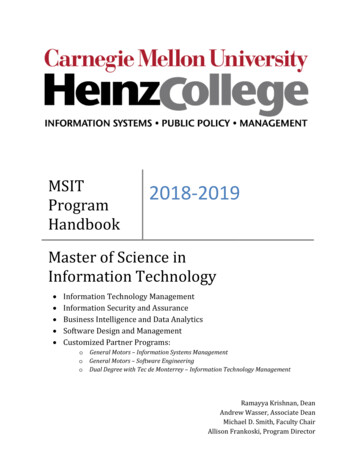
Transcription
MacroeconomicsFifth EditionSTEPHEN D. WILLIAMSONWashington University in St. Louis
Editor in Chief: Donna BattistaAVP/Executive Editor: David AlexanderAcquisitions Editor: Christina MasturzoSenior Editorial Project Manager: Lindsey SloanEditorial Assistant: Emily BrodeurDirector of Marketing: Maggie MoylanExecutive Marketing Manager: Lori DeshazoSenior Marketing Assistant: Kimberly LovatoManaging Editor: Jeffrey HolcombCreative Art Director: Jayne ConteCover Designer: Suzanne DudaCover Art: ShutterstockMedia Project Manager: Lisa RinaldiFull-Service Project Management: Integra SoftwareServices Pvt. Ltd.Printer/Binder: Edwards Bros/Malloy-State StreetCover Printer: Lehigh/Phoenix-HagerstownText Font: Berkeley-BookCredits and acknowledgments borrowed from other sources and reproduced, with permission, in this textbook appearon the appropriate page within text.RRand Windows are registered trademarks of the Microsoft Corporation in the U.S.A. and other countries.Microsoft Screen shots and icons reprinted with permission from the Microsoft Corporation. This book is not sponsored orendorsed by or affiliated with the Microsoft Corporation.c 2014, 2011, 2008 by Pearson Education, All rights reserved. Manufactured in the United States ofCopyright America. This publication is protected by Copyright, and permission should be obtained from the publisher prior toany prohibited reproduction, storage in a retrieval system, or transmission in any form or by any means, electronic,mechanical, photocopying, recording, or likewise. To obtain permission(s) to use material from this work, pleasesubmit a written request to Pearson Education, Inc., Permissions Department, One Lake Street, Upper Saddle River,New Jersey 07458, or you may fax your request to 201-236-3290.Many of the designations by manufacturers and sellers to distinguish their products are claimed as trademarks.Where those designations appear in this book, and the publisher was aware of a trademark claim, the designationshave been printed in initial caps or all caps.Library of Congress Cataloging-in-Publication DataWilliamson, Stephen D.Macroeconomics / Stephen D. Williamson. – 5th ed.p. cm.ISBN-13: 978-0-13-299133-9ISBN-10: 0-13-299133-01. Macroeconomics. I. Title.HB172.5.W55 2014339–dc232012041186109 8 7 6 5 4 3 2 1www.pearsonhighered.comISBN-10: 0-13-299133-0ISBN-13: 978-0-13-299133-9
CONTENTSPA RT IIntroduction and Measurement IssuesChapter 1Introduction12What Is Macroeconomics? 2Gross Domestic Product, Economic Growth,and Business Cycles 3Macroeconomic Models 7Microeconomic Principles 10Disagreement in Macroeconomics 11What Do We Learn from Macroeconomic Analysis? 12Understanding Recent and Current Macroeconomic Events 15Chapter Summary 33Problems 35Key Terms 33Working with the Data 36Questions for Review 34Chapter 2Measurement 37Measuring GDP: The National Income and Product Accounts 37Nominal and Real GDP and Price Indices 46MACROECONOMICS IN ACTION: Comparing Real GDP AcrossCountries and the Penn Effect 54MACROECONOMICS IN ACTION: House Prices and GDPMeasurement 55Savings, Wealth, and Capital 57Labor Market Measurement 58MACROECONOMICS IN ACTION: Alternative Measures of theUnemployment Rate 60Chapter Summary 62Problems 64Key Terms 62Working with the Data 67Questions for Review 64Chapter 3Business Cycle Measurement 68Regularities in GDP Fluctuations68iii
ivContentsMACROECONOMICS IN ACTION: Economic Forecasting and theFinancial Crisis 71Comovement 72The Components of GDP 78Nominal Variables 81Labor Market Variables 84MACROECONOMICS IN ACTION: Jobless Recoveries 86Seasonal Adjustment 88MACROECONOMICS IN ACTION: The Great Moderation and the2008–2009 Recession 89Comovement Summary 91Chapter Summary 92Problems 94Key Terms 92Working with the Data 94Questions for Review 93PA RT I IA One-Period Model of the MacroeconomyChapter 4Consumer and Firm Behavior: The Work–LeisureDecision and Profit Maximization 9695The Representative Consumer 97The Representative Firm 116MACROECONOMICS IN ACTION: How Elastic is LaborSupply? 117MACROECONOMICS IN ACTION: Henry Ford and Total FactorProductivity 127THEORY CONFRONTS THE DATA: Total Factor Productivity and theU.S. Aggregate Production Function 128Chapter Summary 131Problems 134Key Terms 132Working with the Data 136Questions for Review 133Chapter 5A Closed-Economy One-Period MacroeconomicModel 137Government 138Competitive Equilibrium 138Optimality 145Working with the Model: The Effects of a Change in GovernmentPurchases 151THEORY CONFRONTS THE DATA: Government Spending in WorldWar II 153Working with the Model: A Change in Total FactorProductivity 154
ContentsTHEORY CONFRONTS THE DATA: Total Factor Productivity, RealGDP, and Energy Prices 159MACROECONOMICS IN ACTION: Government Expenditures and theAmerican Recovery and Reinvestment Act of 2009 162A Distorting Tax on Wage Income, Tax Rate Changes, and the LafferCurve 166A Model of Public Goods: How Large Should the GovernmentBe? 173Chapter Summary 177Problems 179Key Terms 177Working with the Data 181Questions for Review 178Chapter 6Search and Unemployment182Labor Market Facts 183MACROECONOMICS IN ACTION: Unemployment and Employmentin the United States and Europe 187A Diamond-Mortensen-Pissarides Model of Searchand Unemployment 189Working with the DMP Model 199MACROECONOMICS IN ACTION: Unemployment Insurance andIncentives 201THEORY CONFRONTS THE DATA: Productivity, Unemployment, andReal GDP in the United States and Canada: The 2008–2009Recession 207A Keynesian DMP Model 209MACROECONOMICS IN ACTION: The Natural Rate ofUnemployment and the 2008–2009 Recession 213Chapter Summary 214Problems 216Key Terms 215Working with the Data 217Questions for Review 215PA RT I I IChapter 7Economic Growth 219Economic Growth: Malthus and Solow220Economic Growth Facts 221The Malthusian Model of Economic Growth 226The Solow Model: Exogenous Growth 237THEORY CONFRONTS THE DATA: The Solow Growth Model,Investment Rates, and Population Growth 250MACROECONOMICS IN ACTION: Resource Misallocation and TotalFactor Productivity 252v
viContentsMACROECONOMICS IN ACTION: Recent Trends in EconomicGrowth in the United States 253Growth Accounting 254MACROECONOMICS IN ACTION: Development Accounting 261Chapter Summary 263Problems 265Key Terms 264Working with the Data 267Questions for Review 264Chapter 8Income Disparity Among Countries and EndogenousGrowth 268Convergence 269THEORY CONFRONTS THE DATA: Is Income Per Worker Convergingin the World? 274MACROECONOMICS IN ACTION: Measuring Economic Welfare: PerCapita Income, Income Distribution, Leisure,and Longevity 275Endogenous Growth: A Model of Human CapitalAccumulation 276MACROECONOMICS IN ACTION: Education and Growth 285Chapter Summary 287Problems 288Key Terms 287Working with the Data 289Questions For Review 287PA RT I VChapter 9Savings, Investment, and Government Deficits 291A Two-Period Model: The Consumption–SavingsDecision and Credit Markets 292A Two-Period Model of the Economy 293THEORY CONFRONTS THE DATA: Consumption Smoothing and theStock Market 309The Ricardian Equivalence Theorem 321MACROECONOMICS IN ACTION: The Economic Growth and TaxRelief Reconciliation Act and National Saving 331THEORY CONFRONTS THE DATA: Government FinancingArithmetic: Are Government Budget Deficits Sustainable? 333Chapter Summary 336Problems 339Key Terms 337Working with the Data 341Questions for Review 338Chapter 10Credit Market Imperfections: Credit Frictions,Financial Crises, and Social Security 342Credit Market Imperfections and Consumption344
ContentsCredit Market Imperfections, Asymmetric Information, and theFinancial Crisis 347THEORY CONFRONTS THE DATA: Asymmetric Information andInterest Rate Spreads 349Credit Market Imperfections, Limited Commitment,and the Financial Crisis 351THEORY CONFRONTS THE DATA: The Housing Market, Collateral,and Consumption 354THEORY CONFRONTS THE DATA: Low Real Interest Rates and theFinancial Crisis 361Social Security Programs 363MACROECONOMICS IN ACTION: Transitions from Pay-As-You-Goto Fully Funded Social Security 369Chapter Summary 370Problems 372Key Terms 371Working with the Data 374Questions for Review 371Chapter 11A Real Intertemporal Model with Investment375The Representative Consumer 376The Representative Firm 382THEORY CONFRONTS THE DATA: Investment and the Interest RateSpread 394Government 396Competitive Equilibrium 397The Equilibrium Effects of a Temporary Increase in G: Stimulus, theMultiplier, and Crowding Out 408MACROECONOMICS IN ACTION: The Total Government SpendingMultiplier: Barro vs. Romer 412The Equilibrium Effects of a Decrease in the Current CapitalStock K 414The Equilibrium Effects of an Increase in Current Total FactorProductivity z 415The Equilibrium Effects of an Increase in Future Total FactorProductivity, zœ : News About the Future and AggregateEconomic Activity 418THEORY CONFRONTS THE DATA: News, the Stock Market, andInvestment Expenditures 419Credit Market Frictions and the Financial Crisis 421THEORY CONFRONTS THE DATA: Interest Rate Spreads andAggregate Economic Activity 423Sectoral Shocks and Labor Market Mismatch 425vii
viiiContentsTHEORY CONFRONTS THE DATA: The Behavior of Real GDP,Employment, and Labor Productivity in the 1981–1982 and2008–2009 Recessions 428Chapter Summary 431Problems 433Key Terms 432Working with the Data 435Questions for Review 432PA RT VMoney and Business Cycles 437Chapter 12Money, Banking, Prices, and Monetary Policy438What Is Money? 439A Monetary Intertemporal Model 440A Level Increase in the Money Supply and MonetaryNeutrality 454Shifts in Money Demand 457THEORY CONFRONTS THE DATA: Instability in the Money DemandFunction 460The Short-Run Non-Neutrality of Money: Friedman–Lucas MoneySurprise Model 462The Zero Lower Bound and Quantitative Easing 472MACROECONOMICS IN ACTION: Empirical Evidence onQuantitative Easing 475Chapter Summary 478Problems 481Key Terms 479Working with the Data 482Questions for Review 480Chapter 13Business Cycle Models with Flexible Prices andWages 483The Real Business Cycle Model 485A Keynesian Coordination Failure Model 493MACROECONOMICS IN ACTION: Business Cycle Models and theGreat Depression 494A New Monetarist Model: Financial Crises and DeficientLiquidity 504MACROECONOMICS IN ACTION: Uncertainty and BusinessCycles 514Chapter Summary 515Problems 517Key Terms 516Working with the Data 518Questions for Review 516Chapter 14New Keynesian Economics: Sticky Prices519The New Keynesian Model 521The Nonneutrality of Money in the New Keynesian Model523
ContentsTHEORY CONFRONTS THE DATA: Can the New Keynesian ModelUnder Fluctuations in the Interest Rate Target Explain BusinessCycles? 525THEORY CONFRONTS THE DATA: Keynesian Aggregate DemandShocks as Causes of Business Cycles 526The Role of Government Policy in the New Keynesian Model 528Total Factor Productivity Shocks in the New KeynesianModel 531MACROECONOMICS IN ACTION: The Timing of the Effects of Fiscaland Monetary Policy 532The Liquidity Trap and Sticky Prices 535MACROECONOMICS IN ACTION: New Keynesian Models, the ZeroLower Bound, and Quantitative Easing 537Criticisms of Keynesian Models 539MACROECONOMICS IN ACTION: How Sticky Are NominalPrices? 540Chapter Summary 541Problems 543Key Terms 542Working with the Data 544Questions for Review 542PA RT V IChapter 15International Macroeconomics 545International Trade in Goods and Assets546A Two-Period Small Open-Economy Model: The CurrentAccount 547THEORY CONFRONTS THE DATA: Is a Current Account Deficit a BadThing? 551Production, Investment, and the Current Account 555MACROECONOMICS IN ACTION: The World “Savings Glut” 562Chapter Summary 563Problems 565Key Terms 564Working with the Data 566Questions for Review 564Chapter 16Money in the Open Economy567The Nominal Exchange Rate, the Real Exchange Rate,and Purchasing Power Parity 568THEORY CONFRONTS THE DATA: The PPP Relationship for theUnited states and Canada 570Flexible and Fixed Exchange Rates 570A Monetary Small Open-Economy Model with a Flexible ExchangeRate 573ix
xContentsTHEORY CONFRONTS THE DATA: Why Did the U.S. CurrencyAppreciate After the Onset of the Financial Crisis? 580A Monetary Small Open Economy with a Fixed ExchangeRate 581MACROECONOMICS IN ACTION: Sovereign Debt and theEMU 590Capital Controls 592MACROECONOMICS IN ACTION: Do Capital Controls Work inPractice? 596A New Keynesian Sticky Price Open-Economy Model 597Chapter Summary 602Problems 605Key Terms 603Working with the Data 606Questions for Review 604PA RT V I IChapter 17Money, Banking, and Inflation 607Money, Inflation, and Banking608Alternative Forms of Money 609MACROECONOMICS IN ACTION: Commodity Money andCommodity-Backed Paper Money Yap Stones and PlayingCards 611Money and the Absence of Double Coincidence of Wants: The Roleof Commodity Money and Fiat Money 612Long-Run Inflation in the Monetary Intertemporal Model 616MACROECONOMICS IN ACTION: Should the Fed Reduce theInflation Rate to Zero or Less? 625Financial Intermediation and Banking 626MACROECONOMICS IN ACTION: Banks, Non-Bank FinancialIntermediaries, Too-Big-to-Fail, and Moral Hazard 637MACROECONOMICS IN ACTION: Bank Failures and Banking Panicsin the United States and Canada 640Chapter Summary 642Problems 644Key Terms 642Working with the Data 645Questions for Review 643Chapter 18Inflation, the Phillips Curve, and Central BankCommitment 646The Phillips Curve 647The Phillips Curve, Inflation Forecasting, and the Fed’s DualMandate 656
ContentsMACROECONOMICS IN ACTION: Commitment and Post FinancialCrisis Monetary Policy in the United States 658Chapter Summary 659Problems 660Key Terms 660Working with the Data 661Questions for Review 660AppendixMathematical Appendix662Chapter 4: Consumer and Firm Behavior 662Chapter 5: A Closed-Economy One-PeriodMacroeconomic Model 666Chapter 6: Search and Unemployment 669Chapters 7 and 8: Economic Growth 672Chapter 9: A Two-Period Model 677Chapter 11: A Real Intertemporal Model with Investment 680Chapter 12: Money, Banking, Prices, and Monetary Policy 682Chapter 17: Money, Inflation, and Banking 687Chapter 18: Inflation, the Phillips Curve, and Central BankCommitment 691Index693xi
PREFACEThis book follows a modern approach to macroeconomics by building macroeconomic modelsfrom microeconomic principles. As such, it is consistent with the way that macroeconomicresearch is conducted today.This approach has three advantages. First, it allows deeper insights into economic growthprocesses and business cycles, the key topics in macroeconomics. Second, an emphasis onmicroeconomic foundations better integrates the study of macroeconomics with approachesthat students learn in courses in microeconomics and in field courses in economics. Learning inmacroeconomics and microeconomics thus becomes mutually reinforcing, and students learnmore. Third, in following an approach to macroeconomics that is consistent with currentmacroeconomic research, students will be better prepared for advanced study in economics.What’s New in the Fifth EditionThe first four editions of Macroeconomics had an excellent reception in the market. In the fifthedition, I build on the strengths of the first four editions, while producing a framework forstudents of macroeconomics that captures all of the latest developments in macroeconomicthinking, applied to recent economic events and developments in macroeconomic policy. Thefinancial crisis in 2008–2009, the resulting worldwide recession, and the responses of monetaryand fiscal policy to these events have introduced a rich array of macroeconomic issues that havebeen addressed in the fourth edition, and further in this revision. The book has been adapted toshow how existing macroeconomic theory allows us to organize our thinking about the recentfinancial crisis and recession. As well, new material has been added to deepen the student’sknowledge of the financial market factors that were important in recent events, and to examineand critically evaluate some of the unusual recent policy interventions by the U.S. governmentand the Federal Reserve System.In more detail, the key changes in the fifth edition are: Chapter 6, “Search and Unemployment,” is entirely new. This chapter presents an accessible version of the search and matching model for which Peter Diamond, Dale Mortensen,and Christopher Pissarides received the Nobel Prize in 2010. This basic search model hasbecome a workhorse for research in labor economics and macroeconomics over the last30 years. This model allows us to understand the determinants of unemployment, and tosuccessfully address some puzzles regarding the recent behavior of labor markets in theUnited States, following the financial crisis.xii
Preface Chapter 11, “A Real Intertemporal Model with Investment,” contains a new section,“Sectoral Shocks and Labor Market Mismatch,” which is important for understanding somefeatures of the 2008–2009 recession and the recovery from the recession. In Chapter 12, “Money, Banking, Prices, and Monetary Policy,” the approach to moneydemand has been simplified, and new material has been added on monetary policy rules,the liquidity trap, and quantitative easing. This material is critical for understandingmonetary policy in the United States and other countries during and since the financialcrisis. In Chapter 13, “Business Cycles with Flexible Prices and Wages,” a new section is includedon “A New Monetarist Model: Financial Crises and Deficient Liquidity,” which capturessome causes of the financial crisis and explores the appropriate policy responses. Chapters 15 and 16, which cover international economics, have been revised extensively.In particular, an addition to Chapter 16 is the treatment of a New Keynesian sticky-priceopen economy model. New end-of-chapter problems have been added. New “Theory Confronts the Data” and “Macroeconomics in Action” features have beenadded to cover recent macroeconomic events and macroeconomic policy issues, particularly as they relate to the financial crisis, and the 2008–2009 recession. The “Working with the Data” sections at the end of each chapter have been revised extensively so students can use the FRED database, provided by the Federal Reserve Bank of St.Louis.StructureThe text begins with Part I, which provides an introduction and study of measurement issues.Chapter 1 describes the approach taken in the book and the key ideas that students shouldtake away. It previews the important issues that will be addressed throughout the book, alongwith some recent issues in macroeconomics, and the highlights of how these will be studied.Measurement is discussed in Chapters 2 and 3, first with regard to gross domestic product,prices, savings, and wealth, and then with regard to business cycles. In Chapter 3, we developa set of key business cycle facts that will be used throughout the book, particularly in Chapters13 and 14, where we investigate how alternative business cycle theories fit the facts.Our study of macroeconomic theory begins in Part II. In Chapter 4, we study the behaviorof consumers and firms in detail. In the one-period model developed in Chapter 5, we capturethe behavior of all consumers and all firms in the economy with a single representative consumer and a single representative firm. The one-period model is used to show how changes ingovernment spending and total factor productivity affect aggregate output, employment, consumption, and the real wage, and we analyze how proportional income taxation matters foraggregate activity and government tax revenue. In Chapter 6, a one-period search model ofunemployment is studied, which can capture some important details of labor market behaviorin a macroeconomic context. This search model permits an understanding of the determinantsof unemployment, and an explanation for some of the recent unusual labor market behaviorobserved in the United States.With a basic knowledge of static macroeconomic theory from Part II, we proceed in PartIII to the study of the dynamic process of economic growth. In Chapter 7 we discuss a set ofeconomic growth facts, which are then used to organize our thinking in the context of modelsxiii
xivPrefaceof economic growth. The first growth model we examine is a Malthusian growth model, consistent with the late-eighteenth century ideas of Thomas Malthus. The Malthusian model predictswell the features of economic growth in the world before the Industrial Revolution, but it doesnot predict the sustained growth in per capita incomes that occurred in advanced countriesafter 1800. The Solow growth model, which we examine next, does a good job of explainingsome important observations concerning modern economic growth. Finally, Chapter 7 explainsgrowth accounting, which is an approach to disentangling the sources of growth. In Chapter 8,we discuss income disparities across countries in light of the predictions of the Solow model,and introduce a model of endogenous growth.In Part IV, we first use the theory of consumer and firm behavior developed in Part IIto construct (in Chapter 9) a two-period model that can be used to study consumption–savings decisions and the effects of government deficits on the economy. Chapter 10 extendsthe two-period model to include credit market imperfections, an approach that is important forunderstanding the recent global financial crisis, fiscal policy, and social security. The two-periodmodel is then further extended to include investment behavior and to address a wide range ofmacroeconomic issues in the real intertemporal model of Chapter 11. This model will then serveas the basis for much of what is done in the remainder of the book.In Part V, we include monetary phenomena in the real intertemporal model of Chapter 11,so as to construct a monetary intertemporal model. This model is used in Chapter 12 to studythe role of money and alternative means of payment, to examine the effects of changes in themoney supply on the economy, and to study the role of monetary policy. Then, in Chapters 13and 14, we study theories of the business cycle with flexible wages and prices, as well as NewKeynesian business cycle theory. These theories are compared and contrasted, and we examinehow alternative business cycle theories fit the data and how they help us to understand recentbusiness cycle behavior in the United States.Part VI is devoted to international macroeconomics. In Chapter 15, the models of Chapters9 and 11 are used to study the determinants of the current account surplus, and the effectsof shocks to the macroeconomy that come from abroad. Then, in Chapter 16, we show howexchange rates are determined, and we investigate the roles of fiscal and monetary policy in anopen economy that trades goods and assets with the rest of the world.Finally, Part VII examines some important topics in macroeconomics. In Chapter 17, westudy in more depth the role of money in the economy, the effects of money growth on inflationand aggregate economic activity, banking, and deposit insurance. Then, in Chapter 18, we seehow central banks can cause inflation, because they cannot commit themselves to a low-inflationpolicy. We also study in this chapter how inflation has been reduced over the last 25 years in theUnited States, and how current monetary policy exposes the U.S. economy to the risk of futureinflation.FeaturesSeveral key features enhance the learning process and illuminate critical ideas for the student.The intent is to make macroeconomic theory transparent, accessible, and relevant.Real-World ApplicationsApplications to current and historical problems are emphasized throughout in two running features. The first is a set of “Theory Confronts the Data” sections, which show how macroeconomictheory comes to life in matching (or sometimes falling short of matching) the characteristics of
Prefacereal-world economic data. A sampling of some of these sections includes consumption smoothing and the stock market; productivity, unemployment, and real GDP in the United States andCanada; the 2008–2009 recesssion; and interest rate spreads and aggregate economic activity.The second running feature is a series of “Macroeconomics in Action” boxes. These realworld applications relating directly to the theory encapsulate ideas from front-line research inmacroeconomics, and they aid students in understanding the core material. For example, someof the subjects examined in these boxes are the natural rate of unemployment and the 2008–2009 recession; business cycle models and the Great Depression; and New Keynesian models,the zero lower bound, and quantitative easing.Art ProgramGraphs and charts are plentiful in this book, as visual representations of macroeconomic modelsthat can be manipulated to derive important results, and for showing the key features of important macro data in applications. To aid the student, graphs and charts use a consistent two-colorsystem that encodes the meaning of particular elements in graphs and of shifts in curves.End-of-Chapter Summary and List of Key TermsEach chapter wraps up with a bullet-point summary of the key ideas contained in the chapter,followed by a glossary of the chapter’s key terms. The key terms are listed in the order in whichthey appear in the chapter, and they are highlighted in bold typeface where they first appear.Questions for ReviewThese questions are intended as self-tests for students after they have finished reading thechapter material. The questions relate directly to ideas and facts covered in the chapter, andanswering them will be straightforward if the student has read and comprehended the chaptermaterial.ProblemsThe end-of-chapter problems will help the student in learning the material and applyingthe macroeconomic models developed in the chapter. These problems are intended to bechallenging and thought-provoking.“Working with the Data” ProblemsThese problems are intended to encourage students to learn to use the FRED database at the St.Louis Federal Reserve Bank, accessible at http://research.stlouisfed.org/fred2/. FRED assemblesmost important macroeconomic data for the United States (and for some other countries aswell) in one place, and allows the student to manipulate the data and easily produce charts. Theproblems are data applications relevant to the material in the chapter.NotationFor easy reference, definitions of all variables used in the text are contained on the end papers.Mathematics and Mathematical AppendixIn the body of the text, the analysis is mainly graphical, with some knowledge of basic algebrarequired; calculus is not used. However, for students and instructors who desire a more rigorous treatment of the material in the text, a mathematical appendix develops the key models andxv
xviPrefaceresults more formally, assuming a basic knowledge of calculus and the fundamentals of mathematical economics. The Mathematical Appendix also contains problems on this more advancedmaterial.FlexibilityThis book was written to be user-friendly for instructors with different preferences and withdifferent time allocations. The core material that is recommended for all instructors is thefollowing:Chapter 1. IntroductionChapter 2. MeasurementChapter 3. Business Cycle MeasurementChapter 4. Consumer and Firm Behavior: The Work–Leisure Decision and Profit MaximizationChapter 5. A Closed-Economy One-Period Macroeconomic ModelChapter 9. A Two-Period Model: The Consumption–Savings Decision and Credit MarketsChapter 11. A Real Intertemporal Model with InvestmentSome instructors find measurement issues uninteresting, and may choose to omit parts ofChapter 2, though at the minimum instructors should cover the key national income accountingidentities. Parts of Chapter 3 can be omitted if the instructor chooses not to emphasize businesscycles, but there are some important concepts introduced here that are generally useful in laterchapters, such as the meaning of correlation and how to read scatter plots and time series plots.Chapter 6 is a chapter new to this edition, and introduces a search model of unemployment.This is a one-period framework, which fits with the emphasis of Part II on static models, butthe model allows for an explicit treatment of the determinants of unemployment by includinga search friction. The model allows for an interesting treatment of labor market issues, but it ispossible to skip this chapter if the instructor and students prefer to focus on other topics.Chapters 7 and 8 introduce economic growth at an early stage, in line with the modern roleof growth theory in macroeconomics. However, Chapters 7 and 8 are essentially self-contained,and nothing is lost from leaving growth until later in the sequence—for example, after thebusiness cycle material in Chapters 13 and 14. Though the text has an emphasis on microfoundations, Keynesian analysis receives a balanced treatment. For example, we study a Keynesiancoordination failure model in Chapter 13, and examine a New Keynesian sticky price model inChapter 14. Keynesian economics is fully integrated with flexible-wage-and-price approaches tobusiness cycle analysis, and the student does not need to learn a separate modeling framework,as for example the New Keynesian sticky price model is simply a special case of the general modeling framework developed in Chapter 12. Those instructors who choose to ignore Keynesiananalysis can do so without any difficulty. Instructors can choose to emphasize economic growthor business cycle analysis, or they can give their course an international focus. As well, it ispossible to deemphasize monetary factors. As a guide, the text can be adapted as follows:Focus on Models with Flexible Wages and Prices. Omit Chapter 14 (New Keynesian Economics: Sticky Prices).Focus on Economic Growth. Include Chapters 7 and 8, and consider dropping Chapters 12,13, and 14, depending on time available.
PrefaceFocus on Business Cycles. Drop Chapters 7 and 8, and include Chapters 6, 12, 13, and 14.International Focus. Chapt
Social Security Programs 363 MACROECONOMICS INACTION: Transitions from Pay-As-You-Go to Fully Funded Social Security 369 Chapter Summary 370 Key Terms 371 Questions for Review 371 Problems 372 Working with the Data 374 Chapter 11 A Real Intertemporal Model with Investment 375 The Representative Consumer 376 The Representative Firm 382
